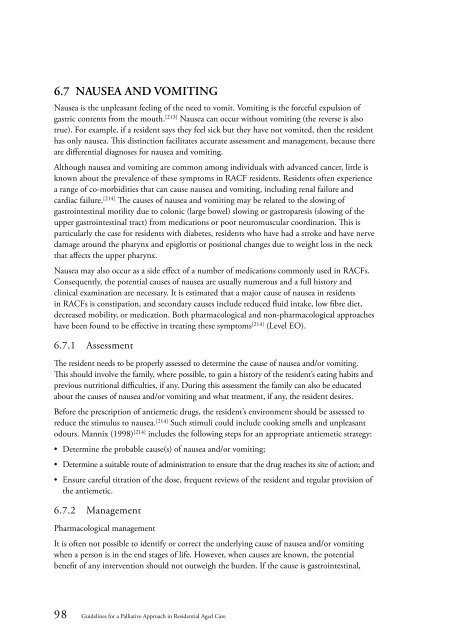Guidelines for a Palliative Approach in Residential Aged Care
Guidelines for a Palliative Approach in Residential Aged Care
Guidelines for a Palliative Approach in Residential Aged Care
Create successful ePaper yourself
Turn your PDF publications into a flip-book with our unique Google optimized e-Paper software.
6.7 NAUSEA AND VOMITING<br />
Nausea is the unpleasant feel<strong>in</strong>g of the need to vomit. Vomit<strong>in</strong>g is the <strong>for</strong>ceful expulsion of<br />
gastric contents from the mouth. [213] Nausea can occur without vomit<strong>in</strong>g (the reverse is also<br />
true). For example, if a resident says they feel sick but they have not vomited, then the resident<br />
has only nausea. This dist<strong>in</strong>ction facilitates accurate assessment and management, because there<br />
are differential diagnoses <strong>for</strong> nausea and vomit<strong>in</strong>g.<br />
Although nausea and vomit<strong>in</strong>g are common among <strong>in</strong>dividuals with advanced cancer, little is<br />
known about the prevalence of these symptoms <strong>in</strong> RACF residents. Residents often experience<br />
a range of co-morbidities that can cause nausea and vomit<strong>in</strong>g, <strong>in</strong>clud<strong>in</strong>g renal failure and<br />
cardiac failure. [214] The causes of nausea and vomit<strong>in</strong>g may be related to the slow<strong>in</strong>g of<br />
gastro<strong>in</strong>test<strong>in</strong>al motility due to colonic (large bowel) slow<strong>in</strong>g or gastroparesis (slow<strong>in</strong>g of the<br />
upper gastro<strong>in</strong>test<strong>in</strong>al tract) from medications or poor neuromuscular coord<strong>in</strong>ation. This is<br />
particularly the case <strong>for</strong> residents with diabetes, residents who have had a stroke and have nerve<br />
damage around the pharynx and epiglottis or positional changes due to weight loss <strong>in</strong> the neck<br />
that affects the upper pharynx.<br />
Nausea may also occur as a side effect of a number of medications commonly used <strong>in</strong> RACFs.<br />
Consequently, the potential causes of nausea are usually numerous and a full history and<br />
cl<strong>in</strong>ical exam<strong>in</strong>ation are necessary. It is estimated that a major cause of nausea <strong>in</strong> residents<br />
<strong>in</strong> RACFs is constipation, and secondary causes <strong>in</strong>clude reduced fluid <strong>in</strong>take, low fibre diet,<br />
decreased mobility, or medication. Both pharmacological and non-pharmacological approaches<br />
have been found to be effective <strong>in</strong> treat<strong>in</strong>g these symptoms [214] (Level EO).<br />
6.7.1 Assessment<br />
The resident needs to be properly assessed to determ<strong>in</strong>e the cause of nausea and/or vomit<strong>in</strong>g.<br />
This should <strong>in</strong>volve the family, where possible, to ga<strong>in</strong> a history of the resident’s eat<strong>in</strong>g habits and<br />
previous nutritional difficulties, if any. Dur<strong>in</strong>g this assessment the family can also be educated<br />
about the causes of nausea and/or vomit<strong>in</strong>g and what treatment, if any, the resident desires.<br />
Be<strong>for</strong>e the prescription of antiemetic drugs, the resident’s environment should be assessed to<br />
reduce the stimulus to nausea. [214] Such stimuli could <strong>in</strong>clude cook<strong>in</strong>g smells and unpleasant<br />
odours. Mannix (1998) [214] <strong>in</strong>cludes the follow<strong>in</strong>g steps <strong>for</strong> an appropriate antiemetic strategy:<br />
• Determ<strong>in</strong>e the probable cause(s) of nausea and/or vomit<strong>in</strong>g;<br />
• Determ<strong>in</strong>e a suitable route of adm<strong>in</strong>istration to ensure that the drug reaches its site of action; and<br />
• Ensure careful titration of the dose, frequent reviews of the resident and regular provision of<br />
the antiemetic.<br />
6.7.2 Management<br />
Pharmacological management<br />
It is often not possible to identify or correct the underly<strong>in</strong>g cause of nausea and/or vomit<strong>in</strong>g<br />
when a person is <strong>in</strong> the end stages of life. However, when causes are known, the potential<br />
benefit of any <strong>in</strong>tervention should not outweigh the burden. If the cause is gastro<strong>in</strong>test<strong>in</strong>al,<br />
98 <strong>Guidel<strong>in</strong>es</strong> <strong>for</strong> a <strong>Palliative</strong> <strong>Approach</strong> <strong>in</strong> <strong>Residential</strong> <strong>Aged</strong> <strong>Care</strong>
















